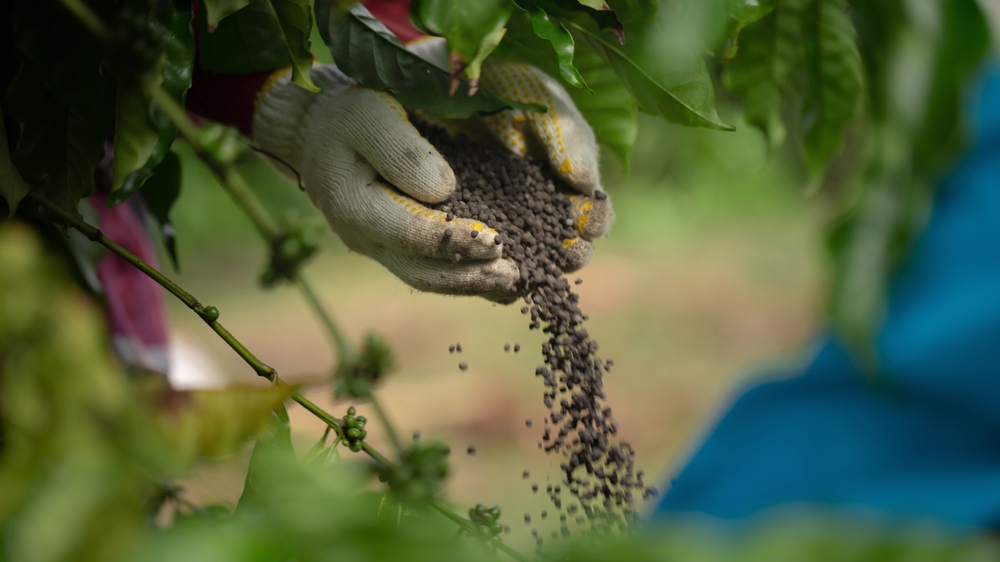
Image Source: Shutterstock.com
You know that feeling when the first chill hits the air, and your lawn looks like it’s begging for attention? You grab your garden gloves, feel unstoppable, and think, “It’s fertilizing time!” But hold up. Not every fertilizer plays nice with cool-season conditions. In fact, using the wrong one right now can backfire—causing stress, waste, or even damage to your lawn and garden.
Before you toss anything into the spreader, let’s talk about five fertilizers that should absolutely stay on the shelf until the weather warms up again.
1. High-Nitrogen Fertilizers
High-nitrogen fertilizers are like an energy drink for your grass—they give it a huge burst of growth and that instant lush green look. But during the cool season, that sudden boost can actually do more harm than good. Grass grows slower in lower temperatures, meaning it can’t absorb all that nitrogen fast enough. The excess just sits there, potentially burning your lawn or washing away into nearby waterways. Instead of fueling healthy roots, you end up forcing tender blade growth that’s weak, shallow, and easily damaged by frost.
2. Fast-Release Synthetic Fertilizers
Fast-release fertilizers promise quick results—and they deliver—but the timing has to be perfect. During cool months, when soil temperatures drop, roots aren’t active enough to absorb all those nutrients. That means most of it ends up wasted or, worse, causes chemical burn to your plants. It’s like handing someone a five-course meal right after they’ve had surgery—they can’t handle it yet. Slow and steady wins the race in the cool season, so save those fast-acting synthetics for the vibrant growth months when your plants can actually put them to good use.
3. Manure-Based Fertilizers
It’s tempting to think organic means always safe, but manure-based fertilizers can spell trouble in the cool season. They’re rich in nitrogen and other nutrients, but they need warmth and microbial activity in the soil to break down properly. In cold weather, that process slows to a crawl, leaving nutrients trapped and unavailable to your plants. Worse yet, partially decomposed manure can introduce harmful pathogens or odors that linger longer in the chill. If you’re craving organic goodness, composted materials that are already broken down are a much safer bet until spring.
4. Phosphorus-Heavy Fertilizers
You’ve probably heard that phosphorus helps with root development—and that’s true—but applying phosphorus-heavy fertilizers in the cool season can easily go overboard. Most established lawns and gardens already have enough phosphorus stored in the soil. When you pile on more during the dormant period, it just sits there, washing away with rain or snowmelt and contributing to runoff pollution. It’s not just bad for your plants—it’s bad for your local ecosystem too. Unless a soil test specifically says you need more, hold off until the growing season kicks back in.
5. Weed-and-Feed Formulas
Weed-and-feed products sound convenient, but in the cool season, they’re a recipe for disappointment. These mixes combine fertilizer with herbicide, and both require active plant growth to work effectively. Cool weather slows down the metabolism of both weeds and grass, so the chemicals never get fully absorbed. You end up wasting money on products that can’t do their job and potentially stressing your turf instead. If you’re tackling weeds, wait until temperatures rise and both your grass and those pesky intruders are awake and ready for action.

Image Source: Shutterstock.com
Timing Is Everything in the Garden
The cool season is a time for roots to rest, not for nutrient overloads or quick fixes. Using the wrong fertilizer now doesn’t just waste product—it can undo months of hard work and preparation. Smart gardeners know that success comes from timing, not just effort, and the cool season is all about patience and protection. Stick to gentle maintenance, keep an eye on soil health, and plan your fertilizing strategy for when warmth returns.
Have you ever made a cool-season fertilizing mistake or found a better alternative? Share your thoughts, tips, or funny mishaps in the comments below.
You May Also Like…
Why You Should Rethink Fall Fertilizer Applications
Why Over-Fertilizing Kills More Plants in Fall
7 Flowers That Only Show Their Best Color in Fall
Why Certain Shrubs Should Never Be Fertilized in Fall
Why Your Lawn Shouldn’t Be Ignored This Season
Leave a Reply